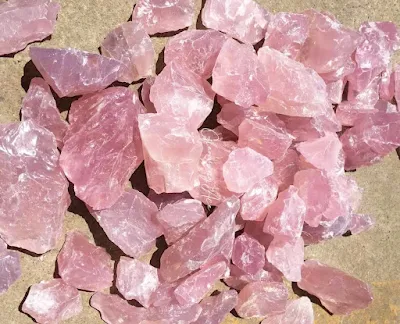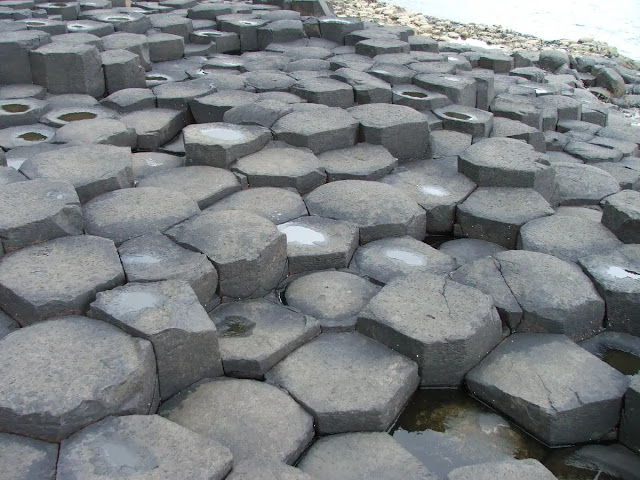Rose Quartz: Pink Quartz, Properties, Uses
Rose quartz is a variety of quartz which exhibits a pink to rose red hue. Rose quartz is one of the most popular gemstones in the world and is often used in jewelry and other decorative objects.
What is Rose Quartz
Rose quartz is a variety of crystalline quartz, which is the most common mineral on Earth. Quartz is made up of silicon and oxygen atoms, and it has a chemical formula of SiO₂.
Rose quartz is commonly found in the quartz cores of pegmatites and is believed to form at high temperatures, but it has also been found in hydrothermal veins. They are found as a late formation in pegmatite pockets, often overgrowing smoky quartz crystals in groups of parallel-grown crystals.
.jpeg) |
| Rose Quartz crystals from Taquaral, Itinga, Minas Gerais, Brazil Photo: The Arkenstone |
Although quartz is one of the most common minerals on Earth, natural rose quartz is one of the rarer colored varieties of crystalline quartz. Still, it’s not an expensive gemstone. The most coveted colors are pure to purplish pink.
The term "rose quartz" has also occasionally been used for quartz that is colored by other inclusions. Pale amethyst may be confused with euhedral rose quartz/pink quartz. Amethyst and euhedral rose quartz/pink quartz are both occasionally found overgrowing smoky quartz and may show similar sheet-like surface patterns.
Rose quartz is a relatively hard mineral, with a hardness of 7 on the Mohs scale. Rose quartz is also brittle, and it can break if it i dropped or hit.
Despite its softness and brittleness, rose quartz is a very popular gemstone. It is often used in jewelry, such as necklaces, bracelets, and earrings. Rose quartz is also used in carvings, sculptures, and other decorative objects.
What Causes the Pink Color of Rose Quartz?
The pink color of rose quartz is caused by trace amounts of impurities in the quartz crystal. The most common impurities that cause the pink color are manganese, iron, and titanium. These impurities replace some of the silicon atoms in the quartz crystal lattice, and they absorb certain wavelengths of light, while they reflect others. The wavelengths of light that are reflected are in the pink range of the spectrum, which is why rose quartz has its characteristic pink color.
The amount of impurity in the quartz crystal determines the intensity of the pink color. Crystals with more impurities will be a deeper pink, while crystals with fewer impurities will be a paler pink. The color of rose quartz can also vary depending on the location where it is found. For example, rose quartz from Brazil is typically a deeper pink than rose quartz from Madagascar.
Rose Quartz Asterism
Rose quartz from some localities shows asterism when cut as spheres or cabochons, much like that seen in certain sapphires. It is sometimes called star rose quartz. The six-rayed star is caused by reflections of the light from embedded fibers that intersect at an angle of 60°.
Crystalline Rose Quartz
Additionally, there is a rare type of pink quartz (also frequently called crystalline rose quartz) with color that is thought to be caused by trace amounts of phosphate or aluminium. The color in crystals is apparently photosensitive and subject to fading. The first crystals were found in a pegmatite found near Rumford, Maine, USA and in Minas Gerais, Brazil.
Rose Quartz is the South Dakota state mineral.
 |
| Asterism rose quartz. Credit: Martin P. Steinbach |
Rose Quartz Properties
Composition: Silicon dioxide (SiO₂) with trace amounts of manganese and titanium.
Color: Soft pink to deeper rose red, sometimes with white or milky patches. The color is caused by traces of manganese ions within the quartz structure.
Luster: Vitreous (glassy), sometimes with a waxy or greasy sheen.
Crystal System: Trigonal
Streak: White, like regular quartz.
Hardness: 7 on the Mohs scale, making it a relatively hard and durable stone.
Cleavage: None, like regular quartz.
Crystal Form: Usually massive, but can also occur in well-formed crystals. Crystals can be prismatic, pyramidal, or bipyramidal. Often found in clusters or druzy formations.
Density: 2.65 g/cm³ to 2.75 g/cm³, slightly denser than regular quartz due to the trace elements.
Transparency: Can range from transparent (rarely) to translucent to opaque, depending on the presence of inclusions and fractures.
Fracture: Conchoidal, like regular quartz.
Solubility: Insoluble in most common solvents, but can be dissolved in hydrofluoric acid.
Magnetism: Non-magnetic, like regular quartz.
Fluorescence: May fluoresce weakly under long-wave ultraviolet light, sometimes with a pinkish or orange glow.
Pleochroism: Weak, may show slight variations in color intensity depending on the viewing angle.
Refractive Index: 1.544 to 1.553, slightly higher than regular quartz due to the higher density.
 |
| Rough massive Rose quartz. |
Rose Quartz Uses
Rose quartz, with its delicate pink hue and gentle energy, has captivated humanity for centuries. Its uses extend far beyond mere aesthetics, encompassing diverse fields and offering a glimpse into its multifaceted nature. Let's explore some of its prominent roles:
1. Aesthetic and Decorative
Jewelry: Rose quartz's soft color and smooth texture make it a popular choice for jewelry, adorning necklaces, bracelets, earrings, and pendants with a touch of romantic charm.
Interior Design: Polished rose quartz pieces add a calming and elegant touch to homes, serving as bookends, decorative accents, or even countertops in luxurious spaces.
Sculptures and Art Objects: Artists find inspiration in rose quartz's natural beauty, crafting sculptures, carvings, and decorative objects that showcase its unique form and color.
 |
| Rough Rose Quartz. Photo: GleamingAce |
2. Metaphysical and Spiritual
Love and Relationships: Rose quartz is often associated with love, promoting emotional healing, self-love, and attracting romantic relationships. Some believe it fosters harmony and understanding in existing partnerships.
Emotional Wellbeing: Rose quartz is said to soothe anxieties, ease stress, and promote peace of mind. Its calming energy can be utilized during meditation practices or simply held for emotional comfort.
Chakra Balancing: In crystal healing practices, rose quartz is associated with the heart chakra, believed to balance its energy and promote emotional well-being.
3. Practical and Industrial
Facial Rollers and Gua Sha Tools: Rose quartz's coolness and smoothness make it a popular material for facial rollers and Gua Sha tools, promoting lymphatic drainage and facial muscle relaxation.
Gemstone Powder: Crushed rose quartz can be used as a gentle exfoliant or added to bath salts and soaps for a touch of luxury and potential skin benefits, though scientific evidence is limited.
Building Materials: Crushed rose quartz can be incorporated into terrazzo flooring or concrete countertops, adding a subtle pink hue and unique texture to these materials.
4. Historical and Cultural
Ancient Civilizations: Rose quartz has been prized for its beauty and purported properties since ancient times. The Egyptians used it in jewelry and amulets, while the Romans believed it held the power to attract love.
Folklore and Traditions: Rose quartz features in various cultures' folklore and traditions, often associated with love, fertility, and emotional well-being.
 |
| Rose Quartz flowers |
Conclusion
Rose quartz transcends its captivating appearance, offering a window into geological processes, historical significance, and potential therapeutic applications. Whether admired for its aesthetic charm, considered a symbol of love and healing, or simply enjoyed for its unique geological history, rose quartz continues to intrigue and inspire.
 |
| Rose quartz pink crystals |
See also:
What Is Faden Quartz, and How Does It Form?
What Causes the Purple Color of Amethyst?
Crystal Formations and Their Meanings




%20(1).webp)




